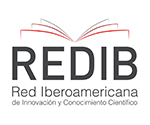Envíos
Lista de comprobación para la preparación de envíos
Como parte del proceso de envío, los autores/as están obligados a comprobar que su envío cumpla todos los elementos que se muestran a continuación. Se devolverán a los autores/as aquellos envíos que no cumplan estas directrices.- El envío no ha sido publicado previamente ni se ha sometido a consideración por ninguna otra revista (o se ha proporcionado una explicación al respecto en los Comentarios al editor/a).
- El archivo de envío está en formato OpenOffice, Microsoft Word, RTF o WordPerfect.
-
Authors are encouraged to include the ORCID number.
- Siempre que sea posible, se proporcionan direcciones URL para las referencias.
- El texto tiene interlineado sencillo; 12 puntos de tamaño de fuente; se utiliza cursiva en lugar de subrayado (excepto en las direcciones URL); y todas las ilustraciones, figuras y tablas se encuentran colocadas en los lugares del texto apropiados, en vez de al final.
-
El texto se adhiere a los requisitos estilísticos y bibliográficos resumidos en las Directrices del autor/a, que aparecen en Acerca de la revista.
- Si se envía a una sección evaluada por pares de la revista, deben seguirse las instrucciones en Asegurar una evaluación anónima.
-
Formulario para la evaluación de artículos para Sinología hispánica. China studies review.
Aviso de derechos de autor/a
Sinologia Hispanica. China Studies Review considers all manuscripts on the strict condition that
- The authors grant on a nonexclusive basis the exploitation rights (reproduction, distribution, public communication and transformation) of the work accepted for publication to the University of León. The authors can establish, on their own, additional agreements for the non-exclusive distribution of the version of the work published in the journal (for example, placing it in an institutional repository or publishing it in a book), always acknowledging the initial publication in this journal.
- The manuscript is your own original work, and does not duplicate any other previously published work, including your own previously published work.
- The manuscript is not currently under consideration or peer review or accepted for publication or in press or published elsewhere.
- The manuscript contains nothing that is abusive, defamatory, libellous, obscene, fraudulent, or illegal.
- Please note that Sinologia Hispanica uses Turnitin software to screen manuscripts for unoriginal material. By submitting your manuscript to Sinologia Hispanica you are agreeing to any necessary originality checks your manuscript may have to undergo during the peer-review and production processes. Any author who fails to adhere to the above conditions will be rejected.
- Authors are allowed and encouraged to electronically disseminate the pre-print versions (version before being evaluated) and / or post-print (version evaluated and accepted for publication) of their works before publication, since it favors their circulation and earlier dissemination and with it a possible increase in its citation and scope among the academic community.
Sinologia Hispanica is under Creative Commons Attribution-NonCommercial-ShareAlike 4.0 International License. You can read more about this license in versión informativa and texto legal.
Declaración de privacidad
El responsable del tratamiento de los datos de carácter personal aportados para las revistas que se elaboran, editan y publican, será la Universidad de León. Los datos recogidos serán los necesarios para la gestión editorial de la revista, el acceso a su portal, y su identificación. Los datos recogidos se limitarán únicamente a los estrictamente necesarios para llevar a cabo la finalidad descrita. La base de legitimación es el consentimiento otorgado por parte del propio usuario al acceder o registrarse. Sus datos no serán cedidos a terceros, salvo obligación legal, y sin autorización. Para ampliar toda la información sobre protección de datos puede acceder a la Política de Privacidad y el Aviso Legal de la Universidad de León, dónde se le informará de sus derechos de acceso, supresión, rectificación, oposición, limitación y portabilidad, ante el canal habilitado para ello, pudiendo ponerse en contacto con el delegado de protección de datos en el correo dpd@unileon.es







